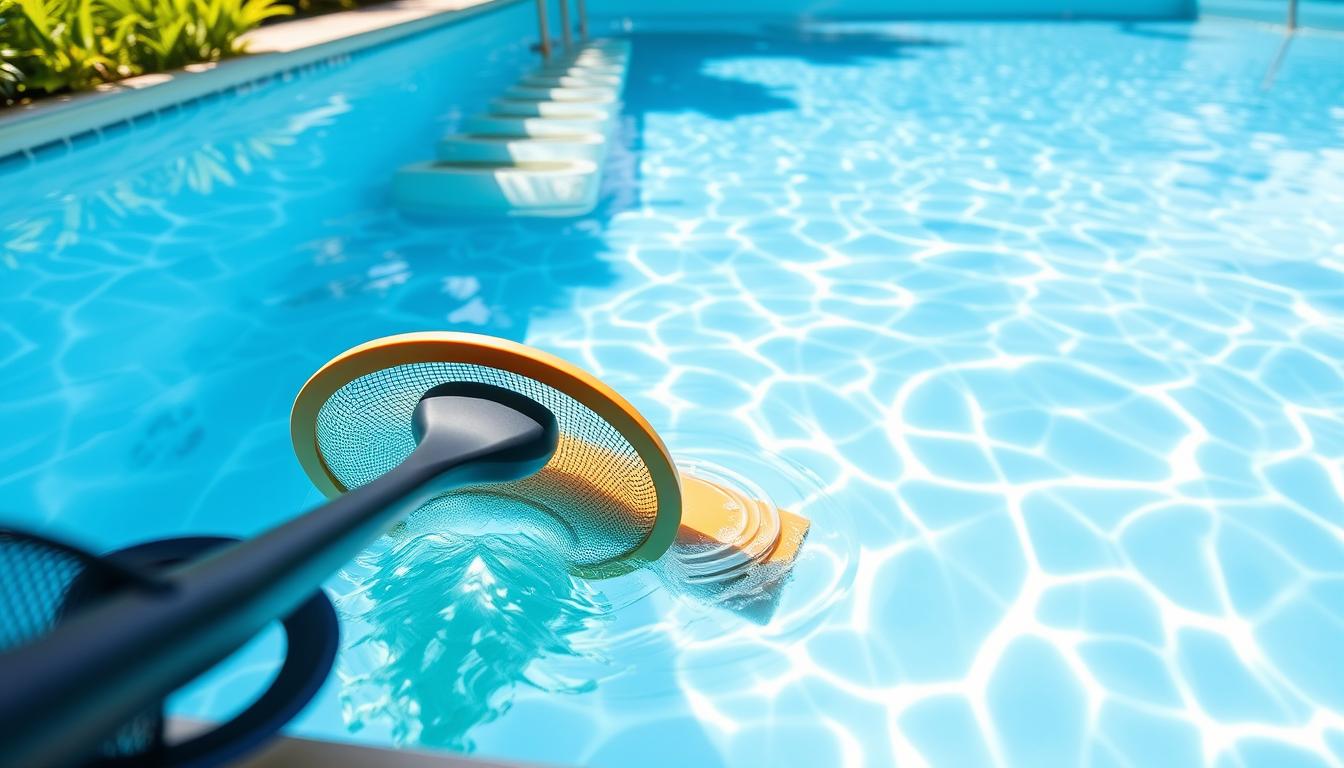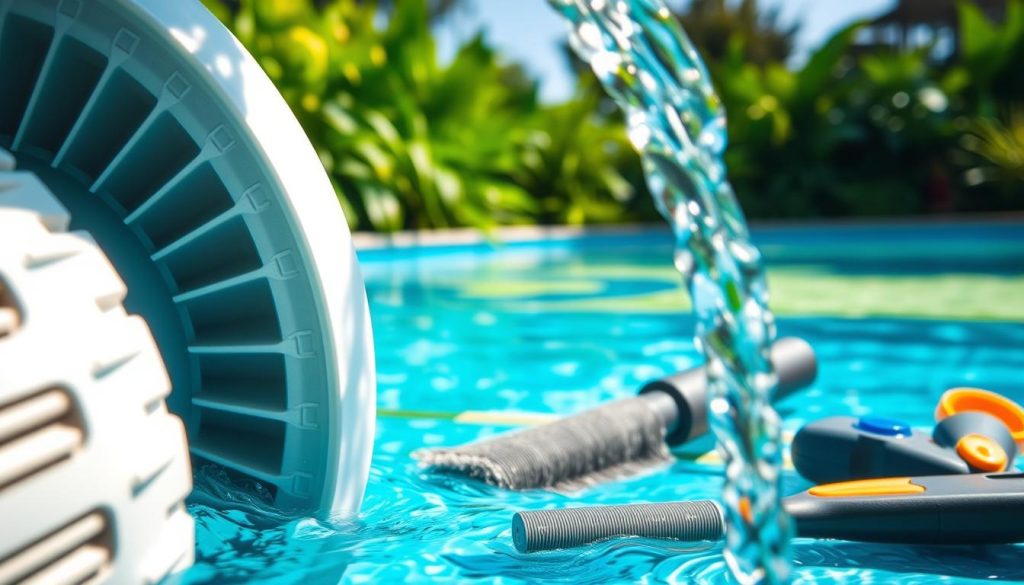
Did you know that 75% of pool draining is for maintenance and repair? Draining your pool isn’t always the best way to fight algae. With proper maintenance and removal strategies, you can beat algae without emptying your pool.
Low chlorine and unbalanced pH often cause algae growth. Lack of stabilizer (cyanuric acid) can make this worse. Green or blue algae are the most common in pools.
Yellow or mustard algae and black algae are less frequent. Most algae are harmless but unsightly. They require pool chemicals and shocking to eliminate.
Key Takeaways
- Draining your pool is not always necessary to remove algae and can lead to costly repairs
- Regular pool maintenance, including proper chlorine and pH levels, can prevent algae growth
- Green algae is the most common type found in pools, while black algae is the most challenging to eliminate
- Pool shock and algaecide are effective treatments for removing algae without draining the pool
- Professional pool maintenance services can help prevent and address algae-related issues
Why Draining Your Pool to Remove Algae is Not Recommended
Draining a green, swampy pool might seem like a quick fix. However, this can harm vinyl liner, concrete, and fiberglass pools. Let’s explore the risks of draining your pool to remove algae.
Risks of Draining Vinyl Liner Pools
Vinyl liner pools can be damaged when drained below safe levels. Direct sunlight can cause the liner to collapse within a day. This can ruin the liner, requiring a full replacement.
Only drain a vinyl pool when you need to replace the liner. This helps avoid costly pool liner damage.
Potential Issues with Draining Concrete and Fiberglass Pools
Concrete and fiberglass pools face dangers from improper draining too. Hydrostatic pressure from the ground can make these pools pop out. This happens when pools are drained without proper care.
Always have pool professionals supervise or perform the draining of concrete or fiberglass pools. Their expertise helps prevent serious damage.
Draining a pool can cause structural damage, buckling, or cracking of pool walls. Areas with expansive soils, like clay, pose higher risks when water is removed.
DIY pool maintenance might seem appealing, but draining a pool is risky. It’s best to leave this task to experienced professionals. They can guide you and suggest safer algae removal methods.
By seeking expert help, you can keep your pool clean and healthy. This approach also protects your pool’s structure from potential harm.
| Pool Type | Draining Risks | Recommended Action |
|---|---|---|
| Vinyl Liner | Liner collapse and damage | Only drain when replacing liner |
| Concrete/Fiberglass | Hydrostatic pressure, popping out of ground | Drain under professional supervision |
Valid Reasons for Draining Your Pool
Draining your pool isn’t always the best choice for algae removal. However, certain situations may require it. Let’s explore valid reasons for draining pools to ensure proper maintenance.
Replacing a Vinyl Pool Liner
Vinyl-lined pools need liner replacement due to age, wear, or damage. This process requires complete pool drainage. It allows for old liner removal and new installation.
Liner replacement is a big task. Yet, it’s crucial for maintaining pool integrity and appearance.
Acid Washing Cement or Gunite Pools
Cement or gunite pools may need acid washing to remove stubborn stains or algae. This process involves draining the pool and applying an acid-water mixture.
Only trained professionals should perform acid washing for safety reasons. A no-drain acid wash might be a budget-friendly alternative.
“Acid washing a pool is a delicate process that requires expertise and caution. It’s always best to leave this task to experienced professionals who can ensure the safety and effectiveness of the treatment.” – Tom Johnson, Certified Pool Operator
Necessary Pool Repairs and Maintenance
Some pool repairs may require draining. These include fixing leaks, replacing damaged tiles, or resurfacing the pool. Draining can help access affected areas.
Certain maintenance tasks, like removing heavy debris, are easier with a drained pool. However, consider draining as a last resort.
Always consult a pool professional to determine the best action for your situation.
| Reason for Draining | Frequency | Professional Assistance |
|---|---|---|
| Vinyl Liner Replacement | Every 10-15 years | Recommended |
| Acid Washing | Every 5-7 years | Required |
| Necessary Repairs | As needed | Recommended |
Pool owners must carefully consider reasons for draining their pools. We should weigh potential risks and benefits. Understanding when draining is necessary helps ensure our pools’ longevity.
Determining If Your Pool Needs to Be Drained
Check your pool’s water clarity and debris levels before draining. If you can see the bottom, draining might not be needed. Regular filter maintenance helps keep water quality high.

Assessing Water Clarity and Debris
Look at your pool’s water clarity first. Cloudy water may mean poor circulation or chemistry issues. Clear water with a visible bottom doesn’t need draining.
Use a leaf rake or pool vacuum to remove debris. This helps maintain water clarity without draining.
Evaluating Your Pool Filter’s Capabilities
Your pool filter’s size and type affect draining needs. Oversized and sand filters handle swampy water better. They remove impurities and keep water clean effectively.
Cartridge filters may struggle with very dirty water. They might need a bypass line for vacuuming. Clean sand filters regularly and replace cartridges as needed.
| Filter Type | Ability to Handle Swampy Water | Maintenance Requirements |
|---|---|---|
| Sand Filters | High | Regular backwashing and cleaning |
| Cartridge Filters | Moderate | Replacement of cartridges as needed |
Commitment to Testing, Dosing, and Cleaning
Avoid draining by sticking to a regular maintenance routine. Test water chemistry often and add chemicals to keep it balanced. Clean pool surfaces and equipment regularly.
Spend up to a week on intense testing, dosing, and cleaning. This can often fix water quality without draining.
A pool should be completely or partially drained every 3 to 5 years to maintain water cleanliness and reduce debris buildup.
Check water clarity and filter abilities before draining your pool. Stick to a good maintenance routine to avoid draining. Draining should be a last resort.
It can be time-consuming and might damage your pool. Ask a pro for a custom plan that fits your pool’s needs.
Effective Algae Removal Techniques Without Draining the Pool
Algae in your pool doesn’t mean you have to drain it. With the right methods, you can remove algae effectively. Start by skimming visible debris with a net. Then, vacuum the pool to waste for a partial drain.
Refill the pool to the proper level after vacuuming. Use a chlorine shock treatment at night to maximize its effect. Keep chlorine levels between 0.7-1.2 ppm for stabilized and 0.4-0.7 ppm for unstabilized chlorine.
If the water stays cloudy, use a flocculant to capture tiny particles. Test and balance the pool water regularly. Maintain pH between 7.0-7.4, alkalinity at 80-150 mg/liter, and hardness at 10-20 f°.
Apply algaecide and phosphate remover to prevent future algae growth. Clean your filter weekly, as poor filtration often causes green water. With these steps, you’ll enjoy a clear, algae-free pool without draining it fully.







